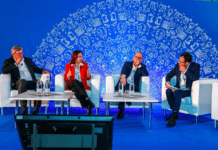3,200 VISITORS
FROM 91 COUNTRIES
172 EXHIBITING COMPANIES
60 EXPERT CONFERENCE SPEAKERS
Tissue World 2019 – the world’s largest tissue industry exhibition and conference – played host to over 3,200 trade professionals from 91 countries. Held at the Fieramilanocity, Milan, more than 170 companies showcased on the exhibition floor.
Tissue World 2019 has welcomed 3,200 participants from 91 countries, with the highest number of attendees coming from Italy, Germany, USA, Turkey, UK, Spain, Serbia, and Sweden.
Held at Fieramilanocity, Milan, from 25-27 March, the world’s largest dedicated tissue industry event featured 172 exhibiting companies showcasing the latest technical and innovative developments.
A three-day conference – ‘Smart and Sustainable – Strategies to Stay Sharp as a New Decade Dawns’ – heard the latest from 60 expert speakers, including the keynote address entitled ‘Creating today a sustainable business for tomorrow’, delivered by Essity president and chief executive Magnus Groth (see TWM’s Exitissues for a detailed article on the talk).
It also included a Senior Management Symposium, Technical Sessions, and a Yankee Dryer Workshop.
New to this year’s event was the ‘Mill of the Future Zone’ where visitors donned VR headsets to experience the very latest tissue making technologies, with solutions from Andritz, Firefly, Körber Digital, Valmet
and Voith.
The Tissue World magazine Mills Awards were also held for the second time and bestowed awards in two categories.
The award for Best Tissue Marketing Strategy was shared by two companies: Essity for its ‘Take Back the Lunch break’ campaign, which promoted data demonstrating the benefits of lunch breaks for employee productivity and happiness; and Hayat Kimya for its successful creation of a new product category – detergent wipes – offering consumers the practicality of tissue paper and the hygiene of detergent in just one product.
Essity won the award for Most Energy- Aware Mill, showcasing a solid track record of improvement in energy consumption on its Lucca operations site.
Having reduced its energy use by 13% over the last 10 years, the company reduced it a further 5% in 2017 and 2018 – the equivalent to the CO2 emissions produced by 1,300 cars travelling an average 15,000km.
Two networking functions were held: Tissue World’s Aperitivo on the first evening, and the traditional Happy Hour on the second evening with live swing music.
TISSUE WORLD – AND 2021
Tissue World has kept its vow to circulate and will move its 2021 event to Düsseldorf, Germany.
Since the launch of the first Tissue World back in 1993, the event has taken place in different European cities.
After two editions in Italy, in a great city that graced us with its design, quality and impeccable services, Düsseldorf has been carefully chosen based on an in-depth market study and survey responses from industry stakeholders.
The move will offer new business opportunities for all industry players.
Built on 26 years of history, Tissue World covers the entire tissue value chain, from raw material suppliers, finished product manufacturers, jumbo roll suppliers, converters, traders to paper machinery makers, packaging equipment suppliers and many more.
Tissue World trade shows and conferences currently take place across five
cities: Milan, São Paulo, Miami, Bangkok and Istanbul.
Tissue World also publishes Tissue World magazine, the leading independent news provider for the global tissue business.
Tissue World Milan 2019 was proud to be supported by the following industry sponsors:
- TREBOR: Banner & Directional Signage Sponsor
- ELETTRIC80 and BEMA: Aperitivo and Conference Tote Bag Sponsor
- ICM MAKINA: Visitor Badge Sponsor
- HAYAT KIMYA: Lanyard Sponsor
- LILA GROUP: Visitor Tote Bag Sponsor
- 9.SEPTEMBAR: Napkin Box Sponsor
- TOSCOTEC: Yankee Safety & Reliability Workshop Sponsor
- SVECOM: WiFi & Matchmaking App Sponsor.
CONFERENCE – SENIOR MANAGEMENT SYMPOSIUM: A SUMMARY OF THE KEY TALKS
WORLD TISSUE MARKET OUTLOOK: WITH FOCUS ON EUROPE
Esko Uutela, principal, tissue, Fastmarkets RISI
Recent global trends
World tissue consumption by region, 2017: Market is dynamic – global consumption: 37.7m tonnes (2017); China has passed Western Europe in market size, while Asia Far East and Eastern Europe are now larger than Japan. China has been the largest producer country since 2015. In 2018, the benchmark of 39m tonnes was likely exceeded.
Growth in the global tissue market
Relatively stable growth until the Great Recession in 2009, recent years have been strong with 3.8% growth rates, and in 2015 even 4.1%.
Volume growth of tissue consumption, 2007-2017.China accounted for 41% of growth, North and Latin America share second place.
The North American tissue market has been strong recently.
The AfH sector in particular benefitted from the strong economy and low gasoline prices in 2015-2016; 2016 growth extremely high at 3.2%; 2017 1.9% and 2018 2.3%.
US tissue import growth, 2010-2018: Canada continues to be the main US import source for tissue, but China has taken the second position ahead of Mexico and Indonesia. However, imports tariffs will likely restrict imports or at least growth in imports from China from 2019 onward.
Trade wars will likely change supply patterns:
• Canada imposed a 10% duty on imports of certain goods from the
USA, including tissue, effective 1 July 2018, as a protest to US taxes for
steel and aluminium. However, the US trade statistics do not show any major decrease in tissue exports to Canada since then, but longer-term effects cannot be excluded.
• China has raised import taxes of 20% for all tissue products imported
from the USA except for the category 48.18.90 (hospital and diverse tissues),
whose rate is 5%. However, this is a rather unimportant issue as US tissue
exports to China were not more than about 5,000 tonnes in 2017.
• The trade war between China and the USA escalated in September 2018
when the USA announced a 10% tariff on US$200bn worth of Chinese
goods imported to the USA, including all the main categories of tissue with
the exception of 48.18.90. This is a major issue as China is the second-largest
import source of tissue after Canada. In 2018, tissue imports from China were about 336,000 tonnes, which corresponds to the capacity of five large tissue machines! The 10% tariff has been partly offset by the weakening of the Chinese exchange rate.
• However, there is the threat that the tariffs on China could go up to 25% in
near future if no new agreement in the trade war can be reached. This decision has been delayed but if coming, it would certainly cut tissue imports from China, and alternative sources may not be able to replace the whole quantity.
US tissue imports from China by main category, 2010-2018
Main categories likely to suffer; however, the “other tissue” category may grow as there is no duty on that category.
Changes in the retail sector – There are some important changes in the US retail sector, which mean new challenges to tissue product suppliers.
• One of the most important recent developments is the entry of the German hard discounter Lidl in the US market, with more than 50 outlets opened and more coming, although the target of 100 outlets within one year was not reached.
• Competing retailers, including the two largest US chains, Walmart and Kroger, are carefully watching Lidl’s activity and pricing strategy, and have reacted by lowering their prices of certain daily goods closer to Lidl’s (and Aldi’s). This is good for consumers, but retailer and supplier margins are under pressure. Lidl’s main focus is on private labels, which are expected to gain market share.
• Online sales are growing and this is changing the traditional retail sector
logistics and thinking—and some players, such as Amazon, have also
entered the brick-and-mortar business.
Expected growth in US tissue consumption by business sector
at-Home retailer labels will show the strongest growth, while At-Home branded volume growth will remain moderate. AfH growth will rise above average At-Home growth.
Major tissue capacity changes in North America, 2018-2021
2018
Georgia-Pacific, Augusta, Georgia 31,000t/a
Sofidel America, Circleville, OH, USA (2 x NTT) 140,000t/a
Kimberly-Clark, Fullerton, CA, USA -60,000t/a
First Quality Tissue, Anderson, SC, USA (TAD PM) 64,000t/a
= 113,000t/a
2019
Soundview Paper, Elmwood Park, New Jersey, USA (closure due to fire) 110,000t/a
Irving Consumer Products, Macon, GA, USA (TAD PM) 64,000t/a
Clearwater Paper, Shelby, NC, USA (NTT PM) 64,000t/a
Cascades Tissue Group, Scarborough and Whitby, ONT, Canada (mill closures) – 61,000t/a
Soundview Elmwood Park, New Jersey, USA (restart) 110,000t/a
Georgia-Pacific Corp., Palatka, FL, USA (TAD PM) 72,000t/a
Sofidel America, Inola, OK, USA 60,000 t/a
= 199,000t/a
2020-2021
First Quality Tissue, Lock Haven, PA, USA 64,000t/a
Sofidel America, Inola, OK, USA 60,000t/a
Kruger Tissue, Brompton, Sherbrook, QC, Canada (TAD PM) 70,000 t/a
= 194,000 t/a.
The outlook is surprisingly good despite the number of projects, but a lot depends on how much tariffs on imports from China change the net trade balance; we assume a conservative decline in the growth of net imports in this forecast.
Closures in 2019 helping substantially, but a lot of new capacity coming on stream that will affect 2020-2021; utilisation rate will slightly head south but still remain rather high if no further major projects emerging.
Latin American outlook
Main Latin American tissue markets, 2017: the five largest markets accounted for 77% of total consumption in 2017, Brazil and Mexico dominate, followed by Argentina, Chile and Colombia. Latin American tissue market shows varying annual growth, change to a more positive
trend expected. Economic turbulence and political instability caused problems and disappointing growth in 2014-2016, mainly due to the Brazilian recession; 2017 was more positive.
Expected volume growth of Latin American tissue demand by main country, 2016-2020
Brazil is expected to recover strongly and Mexico is also back on a growth track. Project delays and stronger demand could help a lot, but the current outlook does not suggest any major improvement.
Western and Eastern European outlook
Western European tissue market showed positive recovery in 2015, but disappointed in 2016-2018. Major variations in growth from year to year, and preliminary data for 2018 suggest it was also not a good year,
with only marginal growth.
Eastern European tissue market growth negatively affected by political tension but now recovering. The Russia-Ukraine conflict has taken its toll on the tissue sector, but 2016 was surprisingly strong, mainly thanks to Poland, the Russian market is in full recovery now.
Growth Rate of Western European Tissue Consumption, 2014-2022
We expect relatively slow growth to continue for this and the next few years, but up from 2018.
Major capacity changes (>10,000 t/a) in the Western European tissue industry, 2018-2020
2018
Cartiera die Pietramelara (Paperdi), Pietramelara, Italy 35,000t/a
Lucart Tissue & Soaps, Aranguren, Bilbao, Spain (restart) 50,000t/a
Essity, Skelmersdale, UK (TAD PM rebuild and restart) 28,000t/a
Goma-Camps, Ejeo de Caballeros, Spain, Italy 34,000t/a
Essity, Allo and La Riba, Spain -76,000t/a
Cartiera della Basilica (Eurovast), Botticino, Italy 10,000t/a
The Navigator Company, Cacia, Aveiro, Portugal 70,000t/a
Ibertissue (Sofidel), Bunuel, Spain 70,000t/a
ICT Iberica, El Burgo del Ebro, Zaragoza, Spain 70,000t/a
Lucart, Porcari, Italy 20,000t/a
= 311,000t/a
2019-2020
Klippans Bruk, Klippan, Sweden 30,000t/a
Global Hygiène, Charavines, France 30,000t/a
Fourstones Group, Sapphire, Leslie, Scotland, UK 28,000t/a
= 88,000t/a
Capacity closures have helped the industry, but new projects thereafter cut the trend; low demand growth lowered capacity utilization in 2018, and new projects in 2019-2020 will keep the outlook moderate in the next couple of years.
Growth rate of Eastern European tissue consumption, 2014-2022
The demand outlook is rather optimistic for tissue market growth in the next few years.
Major capacity changes (>5,000 t/a) in the Eastern European tissue industry, 2018- 2020
2018
Velvet Care, Klucze, Poland 70,000t/a
Vajda Papir, Dunaföldvar, Hungary 32,000t/a
Drenik ND, Belgrade, Serbia 30,000t/a
Hayat Kimya Group, Alabuga, Tatarstan, Russia 70,000t/a
= 202,000t/a
2019-2020
Higi Papersoft (Drenik), Szolnok, Hungary 30,000t/a
Rollpap, Opatovice nad Labem, Czech Republic 7,000t/a
Arkhbum Tissue Group, Vorsino, Kaluga, Russia 70,000t/a
= 100,000t/a
New investments from late 2014 onward and slower demand growth caused capacity utilisation to decline
Minor improvement with recovery in 2016-2017, but new expansions pushing capacity utilisation down again in 2018- 2019
Asian outlook
Main Asian tissue markets, 2017 – China dominant, Asia Far East now larger than Japan.
Recent growth rates of Chinese tissue consumption: The Chinese tissue market has been in a very robust growth phase and is now showing stronger growth than the economy.
Chinese tissue export growth, 2010-2017
Chinese tissue exports exploded in 2011- 2014 and were shipped to nearly every corner of the world—with Asia Far East, North America and Japan the largest buyers, followed by Oceania. Growth waned in 2015, but resumed in 2016-2018 to more than 900,000 tonnes. If the US tariffs on Chinese tissue are raised to 25% as speculated, the growth in exports will likely stop and turn into decline. In 2018, export growth had already stabilised.
Chinese investments exploding, but closures and project delays expected
There is a real investment peak with too much capacity being built, but currently also a wave of capacity closures in the industry—as much as 1.3m tonnes in 2017 and more than 1.0m tonnes in 2018!
The ongoing structural change in the Chinese tissue industry has been very
radical and quick, and it is expected to continue in the next couple of years. New capacity will replace major parts of the older capacity, and older technologies will have no chance to survive. This will help balance the situation to some extent, but it will not totally solve the overcapacity problem.
Overcapacity is obvious, although project delays may help.
Global outlook
Anticipated growth in the global tissue market. Tissue consumption benefitting from improving global economic growth, but there are also uncertainties ahead.
World tissue capacity change, 2005- 2021: Announced tissue capacity expansion clearly exceeds organic market growth. In some years, such as 2019, new capacity coming on stream is double the consumption growth. Closures have helped and will continue to do so in the future, but investment activity is overheated.
The tissue sector is attracting too many investments. Major capacity closures could improve outlook, but only marginally.
Global overcapacity is the name of the game!
BETWEEN RISKS AND OPPORTUNITIES, REIMAGINING THE FUTURE OF RETAIL TISSUE IN WESTERN EUROPE
Manon Quilleré, research analyst, Euromonitor International, UK
Retail tissue: key trends and challenges
• No Deal Brexit scenario. Would be translated in a loss of USD68m in value
and 140,000 Tonnes in volume.
• Rise of private label. In a mature market like WE, tissue products are highly commoditised. Collectively, private label products accounted for
55% of the value of the market in 2018.
• Sustainability becoming a major focus for both consumers and manufacturers.
• Developing an effective online presence.
• WE: Third largest market in the world in terms of value sales for retail tissue.
Despite this high market size, region expected to see sluggish growth over the forecast period, impacted by high levels of household penetration, market saturation, weak population and GDP growth.
Spain: Fifth largest market in the regionin value and volume. On the one hand,retail tissue per capita consumption set to increase by 4% in the next five years. On the other hand, unit prices will be pushed upwards due to increasing costs and premiumisation. Therefore, growth set to be stronger in value than in volume.
Little Room for Growth in WE
Mature market with limited growth potential in terms of per capita consumption. Per capita consumption stood at 8.8kg in 2018. Very high compared to the average per capita consumption in the world (3.3kg).
Unmet market potential measured as the difference between the consumption level today and what it could potentially be in the future. Does not have a specific timeline. Can be met in the next few years or in 20 years or might not be captured at all, depending on market conditions.
Opportunities for incremental retail tissue sales in WE stand at 1.3 million
tonnes. Very little if we compare that to other regions:
• Middle East and Africa: 3.2 million tonnes
• Asia Pacific: 9.8 million tonnes
Since opportunities are limited in volume, interesting to focus on value to develop growth opportunities.
Euromonitor International has identified several megatrends shaping consumer behaviours and attitudes today and in the future. General trends, i.e. can be related to a large number of FMCG industries. We selected 3 megatrends that are the most relevant to tissue.
1. Ethical Living
Ethical Living: being mindful of others when making consumer choices.
The ethicalisation of society is impacted by interlinking spheres of influence: policy, NGO pressure, corporate change, people power.
A few brands have embraced those trends and are doing well as a result. Example of The Cheeky Panda (UK) and Who Gives A Crap (Australia).
Ethical Living feature particularly appealing to Millennials.
What the Millennials want varies from person to person, particularly by culture. However, a number of common wishes can be identified. Want experiences rather than “things”, want good value for money, want products that speak to them, and want to be heard and interacted with.
Are willing to pay more for all organic or natural products. But their needs should not be oversimplified. Also plan to increase spending on private label and to increase visits to discount stores.
2. Middle class retreat
Consumers increasingly conditioned to buy on deal and discount. Can be seen with the rise of discounters. Greece: strong migration towards discounters due to bankruptcy of Carrefour in 2016.
UK: more consumers switching to shopping in Aldi and Lidl, thanks to the
positive perception of quality products offered at a lower price. The economic uncertainty due to the future of the UK after Brexit is also an important factor sending consumers towards discounters.
Aldi and Lidl dominate the retailing landscape in WE. Enjoyed single digit value growth in 2018, unlike Carrefour which is number 3 but registered negative growth during the year.
3. Shopping reinvented
The brandless store: imagine a store without brands. This is what a store in 10 or 15 years could look like. Consumers would only shop by products attributes, functionality, or ingredients. Amazon extending its private
label line: Traditionally, Amazon mostly offering branded tissue products. Launched in 2017 its own label line of tissue products called Presto. Presto set to gain in momentum in the coming years. Voice control devices such as Amazon Echo likely to directly suggest Presto products when consumers order tissue products. Set to also retain consumers in the long run. The convenience of subscription boxes: Another way to retain consumers is
through subscription boxes. Examples of Smooth Panda (Germany) and Les Rois du PQ (Switzerland).
IS THE GLOBAL PULP SHORTAGE GOING TO CONTINUE?
Tomi Amberla, principal, Pöyry Management Consulting, Finland
Pulp is the most important cost driver in tissue. More than 70% of the jumbo reel manufacturing costs, and more than 50% of toilet paper.
Unscheduled downtime was the key pulp price driver in 2017-2018. Most of the 2017-18 pulp price increase due to unforeseen production losses. Major production losses in 2017-2018. Tightness of the pulp market would have disappeared already by Q3/2017, had not been for exceptionally large unscheduled production losses.
Market balance outlook
Demand for fibre continues on healthy growth track World consumption of
papermaking fibre is forecast to grow by 1.3%/a in the long term. China continues as the main growth driver in pulp market China accounts for 60% of the projected market BKP demand increment through 2030
Decided and planned market BKP capacity changes
Net change around 11 Mt of additional capacity if all decided and planned
capacity expansions were realised on their announced schedules
Gradual tightening balance towards early 2020’s
Moderate softness in global pulp market expected through early 2019, thereafter, gradually tightening balance due to the solid demand growth and thin project pipeline.
Factors of uncertainty
China RCP import bans
• How will China cope with the major drop of RCP imports?
• A complete ban of RCP bans will be placed in/after 2020?
Unscheduled downtime
• Ageing recovery boilers especially in BSKP
• In BHKP, the volume impacts of any production losses are becoming more
substantial due to the larger scale of assets.
Alternative uses of pulp
• Conversions from paper grade pulp to dissolving are foreseen to continue.
• The main upside risks for dissolving pulp demand are interlinked with
the possible success of viscose fibre substituting competing materials
Other
• Global economy & trade policies
• Raw material prices in pulp manufacturing
• De-integration adding market pulp supply at short notice.
How will China cope with a major drop in RCP imports?
Falling RCP imports likely to be partly compensated by virgin fibre
High boiler age and growing mill size add to downtime risks
Mill age adds to downtime and rising mill size boosts the volume impact of even short stops
Factors of uncertainties
Rapid growth in non-paper end-uses of pulp encourages capacity switches from paper grades pulp to alternative uses. Plastic replacement efforts lead to a further upside risk.
Wrap up
• Major production losses in 2017- 18 resulted in pulp shortage and fast market pulp price increases – hitting the profitability of tissue manufacturers in Europe and across the world
• After a softer passage in late 2018 / early 2019, market pulp demand
growth is foreseen to continue strong, while the project pipeline at present is thin
• Consequently, the market pulp balance is expected to tighten towards early 2020s
• Major factors of uncertainties continue to flavour the pulp market through
medium term future. Pulp market volatility is here to stay.
NTERING THE TISSUE BUSINESS – A STRATEGIC MOVE
Nuno Santos, executive director, The Navigator Company, Portugal
Forest is one of the most important pillars for the sustainability of The Navigator Company
WHY TISSUE?
1. Portfolio diversification
• In 2014, The Navigator Company conducted a strategic reflection to identify new opportunities to grow and diversify its business portfolio, resulting in a move into the tissue business.
2. Long-term attractiveness
• Every day product with room for differentiation
• Essential and fast-moving consumer good with (quite) limited substitution threats
• Opportunities for product innovation, quality differentiation and “premiumisation”
• Sizeable market .. with growth potential.
3. Full forest-to-pulp-to-tissue integration
• Incorporation of high-quality virgin pulp of Eucalyptus Globulus to obtain
the softest tissue (consistency, cost and quality advantage)
• Cost synergies in integration with pulp resulting from efficiencies in supply chain and energy (e.g., no pulp transportation, drying and re-watering)
• World-class and state-of-the-art technology solutions in line with Industry
4.0 (better products, lower costs)
• Environmentally-responsible, sustainable and certified raw materials and processes (e.g., ECOLABEL, BRC, FSC and PEFC).
FROM FINE PAPERS TO TISSUE: Major steps in a new direction
• OUR OPERATION IN VILA VELHA DE RÓDÃO: a modern and efficient tissue mill
• Founded in 2009 as an independent tissue producer in Castelo Branco, Portugal
• Established customer base, modern equipment and young & talented
workforce
• Integrated with eucalyptus slush pulp
• Supplied via pipeline by a third-party
• 2x Toscotec tissue machines (60ktonne) tissue paper grades from 14 to 32 g/m2
• 4x Perini converting lines (52ktonne) toilet paper, kitchen roll, professional towel
• 3x OMET napkins lines (8ktonne) 1x MTC hand towel line (5ktonne)
OUR OPERATION IN CACIA: the next generation of tissue production
• Start-up during mid-2018, representing an investment over 120 million euros
• Fully integrated with top-quality Eucalyptus Globulus fiber from our own
pulp mill
• 1x Voith tissue machine (70ktonne) designed to maximise short fibre
incorporation
• 3x Gambini converting lines (50ktonne) toilet paper, kitchen roll, professional towel
• 1x Omet napkins line (4ktonne) Fully automated PR and FP warehousing
• Next generation of tissue production, with unique specs
• 100% virgin pulp, top-quality products (softness, resistance, bulk) and sizeable production units
TISSUE REVENUE EVOLUTION
• avenue for growth and diversification of current portfolio
• Objective of reaching 15-20% of The Navigator Company’s total revenue by 2025, aiming at becoming a relevant European player in this business
TISSUE REVENUE SPLIT
• balanced client portfolio, with a focus on export markets
• Revenue by segment (2018)
• 39% Consumer, 59% AfH, 2% parent reel.
• Revenue by geography (2018)
• 51% Portugal, 35% Spain, 13% France and others.
KEY LESSONS LEARNT
• an ongoing story made of achievements and challenges
ACHIEVEMENTS
• Entering the business via acquisition of an established operation with commercial and technical know-how
• Protecting the development of the business unit by ring-fencing its organisational structure
• Committing to a rapid growth path and strategy,
• expanding installed capacity fourfold in four years
• Pursuing differentiation with our core capabilities,
• namely quality of assets, products and of raw materials
• Replicating a model of long-term partnerships with our customers, our suppliers and other stakeholders.
CHALLENGES
• Integrating a smaller company in a much larger group such as The Navigator Company
• Actively managing cultural differences to align the unit with the group’s vision and values
• Growing pains (team still in build-up phase, operation not yet stabilized, neverending race)
• Burden of proving to be a business at least as profitable as our uncoated paper core business
• Educating customers towards the necessity of price adjustments (i.e. due to cost inflation).

































